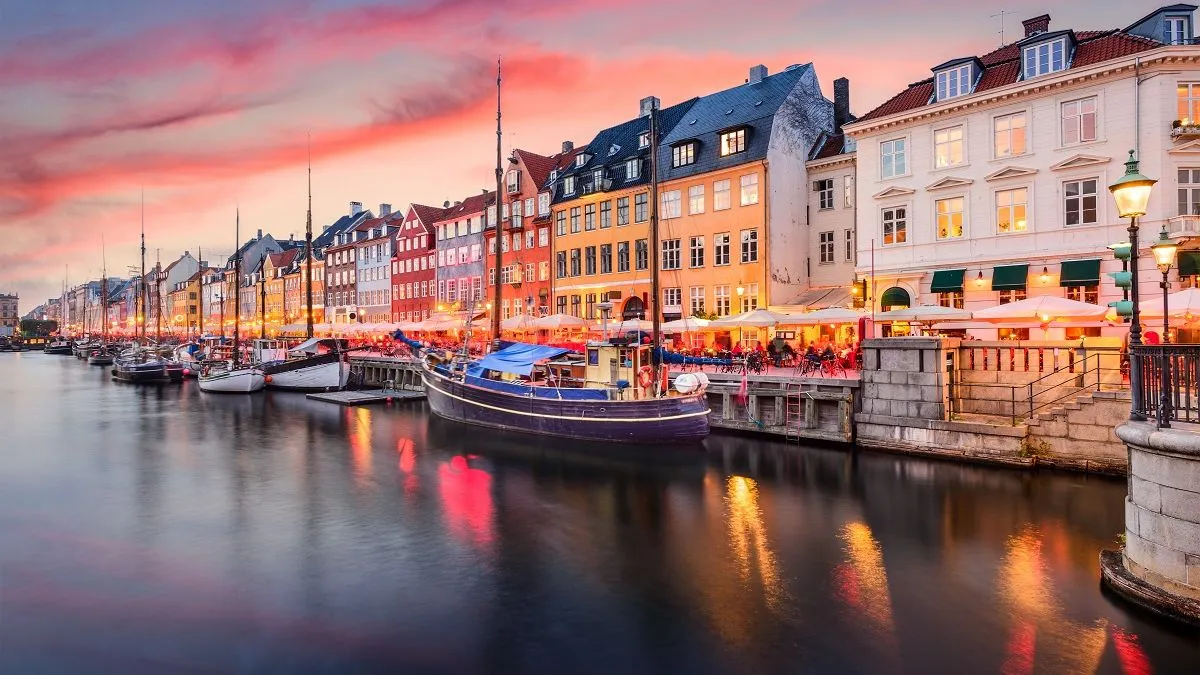15 Copenhagen facts to know before you visit
Tuesday 16 November 2021

The Danish capital is often described as one of the most ‘liveable’ cities in the world and it is also one of the most visited. Its cobbled streets, 1,000 years of royal history and modern Nordic food movement make it a hugely popular destination for holidaymakers.
READ MORE: The Best Movies for Travel Lovers
Why visit Copenhagen?
The team at the iconic Kronborg Castle explain why you should visit Copenhagen and what it is that makes the city so unique: “Copenhagen is quite simply a magical city with copper spires that bear witness to its long history, side by side with stunning modern architecture that places Copenhagen firmly in the 21st century. Although the city is a capital city with over a million people, it feels friendly and cosy, which may be why Denmark is famous for its inbuilt concept of ‘hygge’.
“There are so many activities and places to visit in Copenhagen that you’ll never be bored, but there is also a wealth of experiences to be had just outside Copenhagen. For example, the small city of Helsingør is home to the UNESCO World Heritage Site and the inspiration for Shakespeare’s Hamlet, Kronborg Castle. Just beside this stunning Renaissance Castle is the Danish Maritime Museum, telling the story of Denmark’s history at sea.”
If you’re heading on a luxurious Nordic cruise this year that stops off in Copenhagen, then it’s time to find out what makes it so unique. To help, we’ve created this guide about the 15 things you should know about the city.
1. Copenhagen was a fishing village

Copenhagen, as it is now known, was originally a fishing village called ‘Havn’ and it wasn’t until the late 12th century when Bishop Absalon, an advisor to Danish King Valdemar the Great, moved in that the city’s name changed.
Fortifications were built around the emerging city and as trade continued to grow in the area it became known as København (or Copenhagen in English).
2. Copenhagen has 15 Michelin-star restaurants
Copenhagen has become known as a foodie heaven in recent years, but something that may surprise you is the fact there are lots of Michelin-star restaurants in the capital.
Sine Louise Schmidt, the co-founder and owner of the Copenhagen tour operator Cph:cool, says, “Did you know that Copenhagen has got 15 Michelin restaurants? Since NOMA opened, the food scene has developed into a sophisticated hub focusing on local and seasonal ingredients - and you will find all kinds of options from food halls to food trucks that will contribute to a cosy experience in town.”
READ MORE: Foodie's Guide to Copenhagen, Denmark
3. Two of the oldest amusement parks in the world are in Copenhagen
That’s right. The Danish capital is home to the two oldest amusement parks in the world - a pretty impressive claim to fame.
Melanie, an expat who has lived in Copenhagen for more than eight years and runs the De Jlige Days blog, shares: “Two of the oldest amusement parks in the world are located in or around Copenhagen. Tivoli, in the centre of Copenhagen, is the second oldest and is said to have inspired Walt Disney to create his own parks. In 2018, Tivoli celebrated its 175th birthday. It is also the location of the oldest wooden rollercoaster in the world.
“Bakken, located north of Copenhagen in a historic deer park is the oldest amusement park in the world.”
4. Copenhagen has been voted the best city for urban swimming
Most cities do not have harbours clean enough to swim in and when you think of urban swimming the likes of the Copacabana in Rio or Bondi in Sydney would naturally spring to mind. However, Copenhagen is the world’s best city for swimming.
Cph:cool’s Sine Louise Schmidt adds, “What makes Copenhagen so unique are all the urban outdoor hangouts or living rooms as we call them. Every Copenhagener has got less than ten minutes walking to the nearest park area - and we all have access to swimming in our downtown port/harbour, which is clean and Copenhagen was pointed out as the best city for urban swimming by CNN.”
READ ALSO: Everything you need to know about the northern lights
5. Around half of Copenhageners Cycle

Copenhagen is well known for its love of cycling and one of the most staggering Copenhagen bike facts is the sheer amount of people that cycle regularly, around half of the population! According to a spokesperson from Visit Copenhagen:
“The city has 400 kilometres of bike lanes. According to figures collected by Copenhagen Municipality, around 120,000 people use the cycle bridges over the canals on a daily basis.”
6. Kronborg Castle was the setting for Hamlet
Shakespeare’s Hamlet is one of the world’s most famous plays and it finds its famous setting not far from the Danish capital in a rather majestic royal castle – one of the most important of its kind in Europe.
Nikki Jeffries, from the team at Kronborg Castle, shares some of the castle’s rich history: “Although Kronborg Castle is known for being the setting of Shakespeare’s play, Hamlet, the castle had an illustrious history from 1574, when Frederik II built a magnificent Renaissance castle on the site of an older fortress from the 1420s.
“For 400 years, the castle became the headquarters for the collection of the Sound Dues. Kronborg was a legend in its heyday in the late 1500s. With its menacing guns pointing directly at the ships in the Sound, sailors did not dare to sail past the castle without paying the king his Sound Dues.
“The king's coffers filled, and Frederik II adorned the castle with spires, sandstone and copper roofs. Sailors, merchants, diplomats and aristocrats recounted tales of the magnificent castle and court in Elsinore with its pomp, splendour and cannon blasts that resounded to the toasts that the king proposed.
“The lavish court life vanished from the castle after a devastating fire in 1629. After that, the castle's fortunes faded. For the next 300 years, Kronborg was used as a fortress and barracks for the Danish army.
“Today, life has returned to the castle and 350,000 visitors a year come to visit this UNESCO World Heritage site.”
7. Swimming in the ice-cold sea is popular
Despite the sub-zero temperatures, swimming during the winter is a common activity for local residents in Copenhagen.
De Jlige Days’ Melanie adds: “Copenhagen is a coastal city and it is possible to swim directly in the inner harbour during the summer months at one of the three harbour swimming pools. Just over fifteen years ago this would have been impossible as the water was heavily polluted with sewage, algae, oil spills and industrial waste, now, thanks to a large scan clean-up project, the seawater here is as clean as in the Øresund, the channel between Denmark and Sweden.
“If you are visiting in the winter and you fancy joining the 29,000 registered winter bathers, you can take a dip in the ice-cold sea at Amager Beach, just fifteen minutes from the city centre!”
8. Copenhagen is very green
Copenhagen is a truly green city, and we don’t mean the water and parks dotted across the city. Copenhageners are very environmentally friendly, and the city has previously been voted the European Green Capital.
Visit Copenhagen explains what makes the city so green: “The city’s council is aiming to make Copenhagen the world’s first CO2-neutral capital by 2025, while Copenhageners consume 88% of organic food in the city’s institutions (2016).
“Amager Bakke is also the most effective waste incinerator in the world, and it has to import trash from abroad to keep going.”
READ ALSO: Discover top Reykjavik attractions to visit
9. Copenhagen is easy to get around

Depending on how long you get to spend in the city (Ambassador’s Baltic cruises allow you to spend at least a day here) you can easily get around the city.
Melanie from De Jlige Days blog, shares: “The fact that, although it is a capital city, Copenhagen is easy to get around and you can explore many different parts of the city easily either by public transport, on bikes or on foot. In one day, you can explore lively neighbourhoods such as Vesterbro and Nørrebro, take a canal tour through the oldest parts of the city and enjoy an unforgettable Michelin starred meal in the evening or simply grab a bite from a harbourside food truck and watch the sun set over the city with a beer in hand.”
10. The harbour is so clean that local mussels live there
We know that the harbour in Copenhagen is very clean because of the number of people that love swimming in it, but Visit Copenhagen says that it is so clean that local mussels are farmed here:
“The Copenhagen Harbor is so clean that it has managed to capture local mussel larvae, which are now growing and reproducing in a small ‘garden’.”
11. Copenhagen was also the capital of Norway and Sweden
Back in 1416, Copenhagen wasn’t just named the capital of Denmark but was also the capital of Norway and Sweden.
This situation occurred when the three countries formed the Kalmar Union, which lasted for 150 years as an alliance against German expansion until 1523 when Sweden opted to break away from the union.
12. Copenhagen is home to the world’s largest collection of unopened beer bottles
The Carlsberg Brewery isn’t just one of the world’s most-visited brewery museums but is also home to the world’s largest collection of unopened beer bottles.
Danish engineer Leif Sonne started to collect them back in 1968 and his stash is now housed at Carlsberg. At the last count, there were more than 20,000 bottles.
13. It has one of the world’s longest pedestrian-only shopping streets

Strøget, which is in the centre of Copenhagen, is one of the world’s longest pedestrian-only shopping streets.
While it is now visited by millions of holidaymakers and local residents, original plans to make the streets pedestrian-only were met with protests.
READ ALSO: Must-visit tsarist palaces in St. Petersburg
14. There is a lively jazz scene
Copenhagen is home to a lively jazz scene and there is a yearly festival and dozens of clubs that attract just under a million visitors every year.
Some of the biggest names in jazz have performed in Copenhagen including Miles Davis, Duke Ellington, and Thelonious Monk.
15. You can travel from Copenhagen to Malmö
The 10-mile Øresund Bridge was completed in 2000 and now Copenhageners can travel from the Danish capital to Malmö in Sweden.
Thousands of passengers on the train and more than six million vehicles are estimated to cross this bridge every year.
Fun facts about Copenhagen, Denmark
Copenhagen was a fishing village
Copenhagen has 15 Michelin-star restaurants
Two of the oldest amusement parks in the world are in Copenhagen
Copenhagen has been voted the best city for urban swimming
Kronborg Castle was the setting for Hamlet
Around half of Copenhageners Cycle
Swimming in the ice-cold sea is popular
Copenhagen is very green
Copenhagen is easy to get around
The harbour is so clean that local mussels live there
Copenhagen was also the capital of Norway and Sweden
Copenhagen is home to the world’s largest collection of unopened beer bottles
It has one of the world’s longest pedestrian-only shopping streets
There is a lively jazz scene
You can travel from Copenhagen to Malmö
READ MORE: What to do in Copenhagen
If you like the sound of Copenhagen, make sure to explore the brilliant cruises to Copenhagen to stop off in this wonderful city. Not sure on Copenhagen, why not browse our last-minute cruise deals to find a location that suits you?


